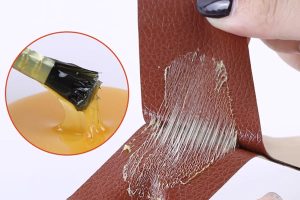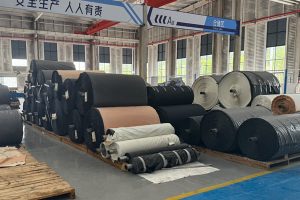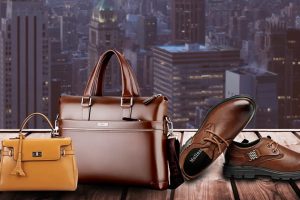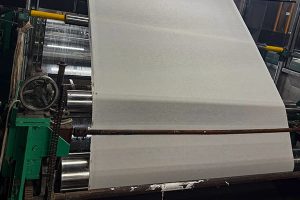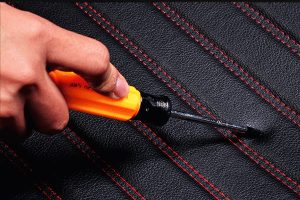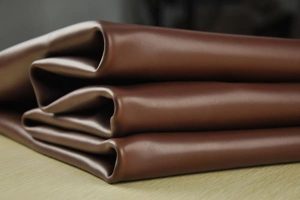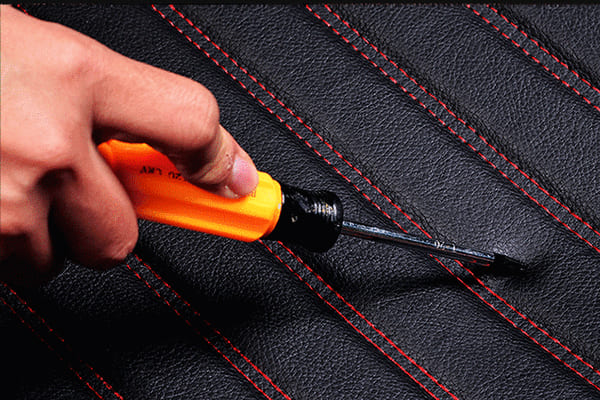
Welcome to the world of leather look fabric, where the only thing real is your desire to look fabulous without emptying your wallet! Imagine strutting down the street in a sleek leather jacket, feeling like a rockstar, all while knowing you didn’t have to give a second thought to animal welfare. Leather look fabric, often dubbed faux leather, is here to save the day—made from synthetic materials like polyurethane or PVC, it offers the stylish sheen of real leather without the hefty price tag or the ethical dilemmas. But what exactly is it made of? And how does it hold up in the wild world of everyday life? Buckle up, because we’re diving deep into the faux-tastic realm of leather look fabric, where durability meets chic and affordability struts hand-in-hand with style. Get ready to explore whether this material is a true leather contender or just a pretender in disguise!
Understanding Leather Look Fabric: What Is It Really Made Of?
Leather look fabric, often referred to as faux leather or synthetic leather, is designed to mimic the appearance of genuine leather without using animal hides. Typically made from polyurethane (PU) or polyvinyl chloride (PVC), this material is engineered to replicate the texture, finish, and sheen of real leather. The manufacturing process involves applying a synthetic layer onto a textile backing, giving it durability while maintaining a flexible and lightweight structure. The result is a versatile fabric that can be used in various applications, from fashion accessories to upholstery. While it offers an attractive aesthetic and is often more affordable than genuine leather, understanding its composition is essential for evaluating its durability and maintenance needs.
Comparative Durability: Leather Look Fabric vs. Genuine Leather
When it comes to durability, there are significant differences between leather look fabric and genuine leather. Genuine leather is known for its robustness and longevity, often lasting for decades when properly cared for. It develops a unique patina over time, adding character and charm. On the other hand, leather look fabric, while generally more resistant to fading and stains, may not withstand the same level of wear and tear. It can be susceptible to cracking and peeling, especially if exposed to extreme temperatures or improper cleaning methods. However, advances in technology have improved the durability of synthetic leathers, with some high-quality options offering impressive resistance to scuffs and abrasion. Ultimately, the choice between the two should consider the intended use; while leather look fabric may be suitable for less demanding environments, genuine leather often remains the gold standard for items that require resilience.
Everyday Use: How Leather Look Fabric Holds Up in Real Life
In everyday scenarios, the performance of leather look fabric can be quite impressive, particularly in casual settings. Many consumers appreciate its ease of maintenance—most spills can be wiped away with a damp cloth, and it generally doesn’t require the same specialized care as genuine leather. This makes it a popular choice for furniture, bags, and clothing that see frequent use. However, while it can handle typical wear and tear, it’s essential to recognize its limitations. For example, sharp objects can easily puncture or scratch the surface, and exposure to direct sunlight for prolonged periods may cause fading. When properly cared for, leather look fabric can remain stylish and functional for several years, making it an excellent option for those seeking the leather aesthetic without the associated costs or animal welfare concerns.
Care and Maintenance: Extending the Life of Leather Look Fabric
Proper care and maintenance are crucial for extending the lifespan of leather look fabric. Unlike genuine leather, which requires conditioning to maintain its suppleness, leather look fabric is relatively low-maintenance. Regular cleaning involves simply wiping it down with a damp cloth to remove dust and spills. For tougher stains, a mild soap solution can be used, but it’s essential to avoid harsh chemicals that could damage the synthetic surface. Additionally, it’s wise to keep leather look items away from direct sunlight, as prolonged exposure can lead to fading or discoloration. Storing items in a cool, dry place can also prevent cracking and peeling. By incorporating these simple care practices, consumers can significantly prolong the life of their leather look fabric products while maintaining their visual appeal.
The Cost Factor: Is It Worth Investing in Leather Look Fabric?
When considering the cost of leather look fabric, it’s important to weigh both its affordability and its value. Typically, leather look fabric is more budget-friendly than genuine leather, making it an attractive option for those who want the leather aesthetic without the higher price tag. However, potential buyers should also consider the longevity of their investment. While leather look fabric can offer a stylish alternative, it may not last as long as genuine leather, which could mean more frequent replacements. This aspect can lead to higher long-term costs if items need to be purchased repeatedly. Ultimately, the decision hinges on individual preferences: if you prioritize style and affordability over longevity, leather look fabric can be a worthwhile investment, especially for fashion-forward pieces that may be trendy for just a season or two.
Fashion Trends: The Role of Leather Look Fabric in Modern Style
Leather look fabric has firmly established itself in the fashion landscape, playing a significant role in contemporary styles. From chic jackets and skirts to stylish handbags and shoes, this material provides the luxurious appearance of leather while being more accessible and versatile. Its popularity can be attributed to its ability to adapt to various trends—from edgy streetwear to sophisticated office attire. Additionally, many fashion designers have embraced leather look fabric for its ability to mimic high-end leather while being available in a wide array of colors and finishes. This adaptability not only caters to diverse consumer tastes but also allows for creativity in design. As sustainability concerns grow, the rise of ethically produced leather look fabric offers an appealing alternative for fashion-conscious individuals seeking stylish yet responsible choices. Overall, leather look fabric continues to be a staple in modern wardrobes, proving that style can be both fashionable and practical.
Conclusion: Faux Fabulous or Just Faux?
In the grand showdown between leather look fabric and genuine leather, one thing is clear: both have their own unique appeal. Leather look fabric offers an accessible, stylish alternative for those who crave the chic aesthetic of leather without the associated costs or ethical concerns. With advancements in technology enhancing its durability and ease of maintenance, it’s no wonder this material has become a staple in modern wardrobes and homes alike.
However, while it can hold its own in everyday scenarios, it may not outlast the true grit of genuine leather, which boasts a timeless allure and unparalleled longevity. Ultimately, the choice comes down to personal preference and lifestyle needs. Whether you opt for the faux fabulousness of leather look fabric or the authentic charm of genuine leather, both can contribute to your style story—so wear what makes you feel great, and remember: confidence is the best accessory, faux or otherwise!


